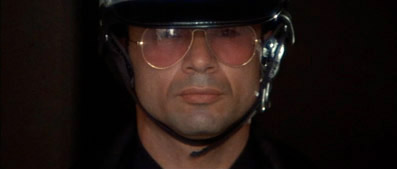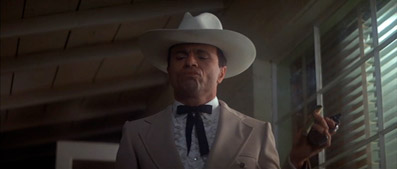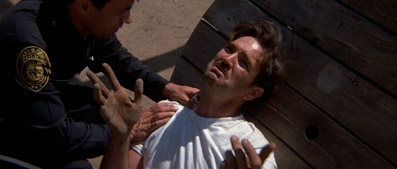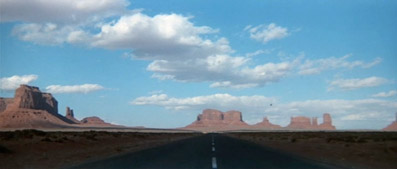| |
First time director James William Guercio wanted the great Conrad L. Hall to photograph this film, but it was not in the budget. Guercio reduced his own salary to one dollar so he could secure Hall as the cinematographer. |
| |
From the Trivia Link on the IMDB |
This is an extraordinary film about moral choice, 'doing the right thing' and an almost pathological desperation runs through its sprockets like mating mambas. It was directed by a man whose passion for his work made his material profit negligible from his own movie. I can only hope his per diems covered his food bills. Further research reveals that Guercio probably wasn't short of a dime or two. He did manage the 70s super-band, Chicago... But this artistic and selfless action summoned up memories of Robert Rodriguez quitting the Directors' Guild of America because it wouldn't allow artist Frank Miller a co-director's credit on Sin City. Commitment like that is hard to find anywhere but in this instance it makes my heart sing. Yes, you could say "What an idiot!" but if this principled sacrifice were to have a happy ending I'd like to think Hall halved his loot with the one dollar-director. No way of knowing if that's the case (unless the director's commentary tells me something I do not know at present; extremely likely. I can't wait to hear that – an experience a week away as I write). Alas no such info but in 1973, Hall was on $10,000 a week. Say what? Superstar salaries didn't start with Nicholson and Cruise...

Electra Glide In Blue is a character study of an earnest and honest man doing America's second most unpopular job. I think traffic wardens are always number one globally. Are there traffic wardens in the US? John Wintergreen is a patrolman on a big bike who stops people for speeding, to search for illegal drugs and is thrust into a murder enquiry where he believes his talents would be best utilised. Guercio really wanted this movie made and I'm at a loss as to why it seems to be regarded by some as the worst kind of fascist trash (thank you Cannes, 1973) and others as one of the best of its genre. I'm in the latter camp, naturally for two very good reasons. Electra Glide In Blue is on the raggedy edge where conservatism clashes headlong into revolution and it's a cracker (no offence meant using that derogatory term for a redneck, sorry, southern Bible belter). A movie about a job traditionally seen as right wing need not have corrupt and violent bastards at its core (or even on its fringes). A man is a man (good and bad, honest and corrupt) and this guy's just working hard at a job regarded a little lower than a flat tyre by those whose lives are interrupted by his meticulousness.
How many movies stay with you? Yes, it depends how old you were when you saw them but I remember not only seeing this movie when I was quite young but also being very troubled by the sexual humiliation scene (calm down, everyone was dressed at the time) and that extraordinary final shot. When the disk came up for review, that image popped up from my memory like a rocket (the machine not the salad leaf). I won't reveal what that image was (could be regarded as a spoiler) but I will say it's been with me for decades and on seeing it again, I'm now firmly convinced that not only was Guercio right in sacrificing all for Conrad Hall, his operator, Thomas Laughridge, should have got an award for the physical operation of that last shot. 'Rock steady on the move' doesn't begin to do the shot justice. Check out the edges of frame and how they always line up with the diminishing parallel lines of the highway. I was and have just been spellbound. Steadicam was just a dream a good three years down the line with Marathon Man making it on to screens before the first feature to be shot with the device, Bound For Glory. Even a moving car could not prompt that level of steadiness and if they were laying tracks they were removing them as quickly, like Gromit in reverse from The Wrong Trousers. Extraordinary.
These are just two instances in a movie full of the very tightest directorial control. We're in Arizona, being shown, in crisply edited snippets, the process of a suicide. One shot bothered me but I was already comfortably nestled in the confident clutches of the story so I let it slide. 'Boom!' and suddenly all the niggles and questions were answered with an exemplary economy and I'd instantly created a real admiration for a first time director and his command of the scene. Thinking I'd got a handle on Guercio's style, along comes an early morning scene with our diminutive hero, John Wintergreen (an utterly earnest and convincing Robert Blake). He's fresh out of bed with his lover and he starts the process of preparing for the day. Another 'hats off' to operator Laughridge. This was 1973 and really fast stocks were still in the future – there must have been fill lights everywhere.

Parts of the picture drift in and out of focus as you're directed to take in certain details and it is done so skilfully that it's only afterwards you realise that (a) the scene is the complete antithesis of the suicide scene and (b) it's all one shot. It's as if preparing to live and preparing to die had to have opposite forms of directorial coverage and it works a bloody treat. It's also, by the director's admission, a way of stopping people slicing up his movie. But then people who slice up movies don't care about aesthetics. What scissor wielding network TV barbarian would say "Hey, we can't cut here because he's racking to the foreground and that's intrinsic to knowing a little more about what motivates the lead character..." No. It'd be more like, "Just cut it there. Fuck art."
Blake as John Wintergreen (how about that for irony in a character's name? The stuff to keep you warm in a location of extreme heat) suits up and we realise that he's a highway patrol man stuck out in the Grand Canyon State where the hippy culture – exploding around the coasts at the time – was not only unwelcome but actively and violently subdued. Every cliché of the lazy and venal cop is explored here but with layers that force you to re-examine the overtly well known. Hippies, doing no more than 'drivin' on Gawd's green earth', are pulled over. Blake is disturbed by his partner's planting of evidence but says nothing. Of course, our hero is straight in every way and it's his ambition to become a homicide detective (more for the clothes he gets to wear it seems, than from the desire to catch murderers). But you have to consider that a homicide cop in 1973's Arizona was a man whose job it was to keep his own bread buttered at all times. Margarine just wouldn't cut the mustard. Mayonnaise have seen the coming of the glory of the Lord. I'll stop now. Violence was de rigueur (think of Regan in the Sweeney as a limp wristed prototype) and it was a man's world in the same way as Sparta used to be (when it was, mystifyingly, populated by Glaswegians).
Blake's partner, Zipper, played by the irrepressibly unique Billy 'Green' Bush, sits in the shade on the job reading comic books. His uniform gives him a licence to mooch. All he wants in life is a luxury motorcycle while his partner dreams of a higher calling. Attending an odd suicide, Blake believes it to be murder and after a very satisfying verbal fight with one Royal Dano (the angel of death from The Right Stuff and supporting actor in a whole slew of highly regarded movies) he's noticed by a real detective and hired as a driver. Be careful what you wish for. Initially thrilled to be one of the higher echelon, Blake soon realises what passes for lawmaking in his corner of the globe. These guys would make Gene Hunt choke on his spaghetti hoops.

The earnest detective-in-waiting is taken to a tavern where he is introduced to his own lover by his boss who assumes she's all his. This scene is electrifying. It is acted so close to the knife's edge, you feel the movie could end there and you'd be satisfied. It shows men's utter helplessness in the arena of sexual competition and women's mastery of emotional torture. Who was it that said that in order to understand men, you just had to imagine they were just little boys? Well, whoever it was could have written this scene. But it's not as if the power all lay in the woman's lap. She's just as frustrated and desperate as the men seeing her relationships with them as a ticket out of the humdrum. Every subsequent scene seemed to leave broken bodies or broken characters in their wakes.
1969's The Wild Bunch (in which Robert Blake turned down the pivotal role of Angel asking for too much money) popularised violent action being given slow motion treatment but Guercio shows a mastery of that form that simply does not seem gratuitous. He makes us feel every glass shard, every elbow and knee collision at 50mph. Yes, there is an argument that after The Wild Bunch (and by implication, The Seven Samurai) that it had just become too damn fashionable not to shoot violence in slow motion but disregarding fads, in 2009, it still works gangbusters. There's a real "ouch' as characters shatter windows off motorcycles at 30mph. Peckinpah was later appalled that audiences 'got off' on his slow motion bloodletting hoping it would have the opposite effect (1969 was deep in Vietnam sanitised TV time). In Electra Glide, you feel the violence. You're seeing things from a very straight laced character's perspective and that helps to bring you around to feel the bad stuff as bad stuff, not a cathartic release because we're all cave men really supposedly thriving on that violence.
The cinematography is luscious and by all accounts, in high definition, it looks gorgeous. The exterior John Ford iconography is all in place while the interiors are littered with grading and freeze frame effects that certainly help to make the movie distinctive. Again, I have not listened to the commentary yet but Wikipedia informs us that after getting Hall to shoot the movie, director and cinematographer disagreed on a broad movie-wide approach and Hall shot the interiors the way he wanted while John Ford was the directorial model on which the exteriors were fashioned. You can't get too much higher a standard than Ford and his beloved, rugged Monument Valley landscapes. Guercio admits that Hall came around to his way of thinking when he finally got Hall out there. However the men worked together, they have produced a film of depth and courage full of earnest men, desperate men whose dreams are predicated on the goodness and altruism of those who wield the wands. Alas, every man for himself. Margaret Thatcher would have made a great state governor... So glad I was 12 years old in the UK at the time.
I have to admit being utterly in love with 70s stock and the lighting cinematographers used to use, especially in the 2.35:1 aspect ratio like this one anamorphically enhanced. There is a creamy richness to the picture that video couldn't capture if you had to stick it in chemicals to coax one out of it. There is precious little dirt but on the wide vistas there is just noticeable grain. I like grain in my movies, like blood in a body. The original sound in 1973 was mostly mono (for the bulk of theatres) but a four track stereo one was created and dusted off and spruced up here with a sort of faux surround based on original tracks and the Dolby Digital 2.0 re-mix works a treat. Road movies thrill a little bit more when the engines are whizzing off right, left and behind you. And there is no real noticeable hiss, which is quite something considering the movies' cost and age.

There only subtitle option I could find was OFF. A little limiting, that choice.
Introduction (9' 32")
STOP! Don't play it! If you've seen the movie, then, OK, go ahead. His intro is akin to Orson Welles introducing Kane with "Rosebud, the essential mystery of Kane is, of course, the..." (I won't ruin that one for you either). Guercio's introduction (after the movie please) is thoughtful, wistful even and he tells many a tale of the film's production and some of that will shock because EGIB looks like a really lush 70s movie, not a cheapo with non-actors and terrible compromises across the board. He does one thing very well in the commentary – he holds back. Here's a man with stories to tell and he defiantly resists telling them – which is fine. You don't see plumbers lining up to tell you all about how they got stiffed over a U-bend bracket one day, do you?
Trailer (3' 08")
Typical 70s fare – sex, guns and the whole plot in one mini-movie. It didn't work to lure audiences in. The movie stiffed at the box office but I'd like to think that the film-makers made something back on TV and DVD sales.
Commentary by Director James William Guercio
A sparse, interesting, if tentative commentary. Here is Guercio being coaxed to say something about his arresting (sorry) movie and the one message that comes through is almost Spielbergian: "I let my work speak for itself..." which is justifiable but if the DVD sales are heightened by a Director's Commentary then he'd better say something. What he does say is always interesting (especially from the perspective of a John Ford fan) but he adds snippets so infrequently. Again you are left with a sense that if a book were written on the making of EGIB it would be a slim volume with an update – after everyone attached to the production was dead – and that would be like four Bibles glued together. Compromise? This movie's compromises were compromised but director, cinematographer and star drive the film into a little niche of cinema history and Guercio rightly acknowledges that.
And still the "Facist!" reactions at Cannes in 1973 surprise me. This is a movie about a firm moral centre existing in a man with, what some may judge, an inherently immoral job. This is the flip side of Easy Rider, seeing things from the other side of the fence but retaining its humanity in the process. This movie dared to say that some cops are cops for the right reasons, the reasons of wanting to do right by others. It's also filled with desperation, something that comes off it like sweat from a farm-hand. It's also beguiling and smart with images that stick. Check out this Wintergreen. It won't keep you warm but he may surprise you.
|